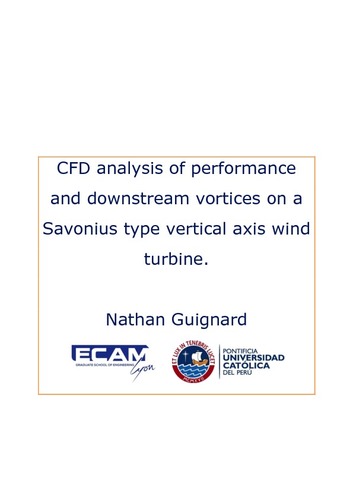| dc.contributor.author | Guignard, Nathan | es_ES |
| dc.date.accessioned | 2016-04-06T22:38:58Z | es_ES |
| dc.date.available | 2016-04-06T22:38:58Z | es_ES |
| dc.date.created | 2015 | es_ES |
| dc.date.issued | 2016-04-06 | es_ES |
| dc.identifier.uri | http://hdl.handle.net/20.500.12404/6686 | |
| dc.description.abstract | Since the turn of the century, the talk about the limited reserve of fossil fuels and the effects of their burning on our climate has become a major topic of the media. The evidence is staggering and as a consequence most of our world’s countries have started an energy transition. The main goal is to get away from fossil fuels and use “renewable energies”, so called because the resources are constantly renewed and compared to fossil fuels seem infinite. Energies such as solar, wind, biomass and geothermal are examples of such sources of renewables. Denmark is the current leader in wind generated electricity, California and Spain are showing how to harness the power of the Sun, and all those efforts to generate more with renewables has to be matched with the effort to make those solutions more efficient and more attractive to other countries who still view fossil fuels as the easy solution and keep on using them. With the knowledge available now renewables it feels for some that burning fossil fuels is a primitive solution. Nonetheless it should be the duty of engineers to enlarge and better that knowledge for everyone to use.
Now more specifically about wind energy. Humans have harvested the energy in the wind for more than 2000 years (the Persians used windmills around 200 B.C.) and with time our technology has improved. They have designed incredible new machines such as the Savonius and Darreus type turbines and their knowledge of fluid dynamics has permitted the implementation of new streamlined blades that harvest more energy from the wind. Albert Betz has shown that a maximum of 59% was the limit for the efficiency of a wind-turbine. They have been getting closer to this number with the years but there is still room for improvement on certain types of turbines. Vertical axis wind turbines (or VAWTs) have always been considered not as suitable for energy production as horizontal type wind turbines. It is true because not all blades are exposed to the wind at all times (like in a horizontal axis wind turbine), but new studies have proved that streamlining the blades a certain way and adding a wing like thickness to them improved the overall efficiency of the turbine. Knowing that and considering that HAWTs are significantly cheaper to produce and maintain than HAWTS, it makes them a more viable solution notably for local decentralized production in isolated areas of the world.That leads to Peru. Peru is a fast growing still yet a 3rd world country. Its potential for renewable energies production (especially wind energy) is tremendous, yet the great amount of gas and oil available in the underground and them coming at a cheap price does not encourage the government to subsidize renewables. It leaves Peru dependent on foreign investments to develop this sector and takes away a great opportunity to forego its energetical transition and get ahead of competition in South America. Some projects have surfaced notably in northern Peru, in the Trujillo region, but there are few compared to the mega industry of oil and gas.
This thesis paper has for goal to further the knowledge of wind turbines in the context of hoping to change Peru’s view on their use and also for the world to use as a database for further research and other works. | es_ES |
| dc.language.iso | eng | es_ES |
| dc.publisher | Pontificia Universidad Católica del Perú | es_ES |
| dc.rights | info:eu-repo/semantics/openAccess | es_ES |
| dc.rights.uri | http://creativecommons.org/licenses/by-nc-nd/2.5/pe/ | * |
| dc.subject | Dinámica de fluidos | es_ES |
| dc.subject | Turbinas eólicas | es_ES |
| dc.subject | Energía eólica--Perú | es_ES |
| dc.title | CFD analysis of performance and downstream vortices on a savonius typer vertical axis wind turbine | es_ES |
| dc.type | info:eu-repo/semantics/masterThesis | es_ES |
| thesis.degree.name | Magíster en Ciencias con mención en Energía | es_ES |
| thesis.degree.level | Maestría | es_ES |
| thesis.degree.grantor | Pontificia Universidad Católica del Perú. Escuela de Posgrado | es_ES |
| thesis.degree.discipline | Ciencias con mención en Energía | es_ES |
| renati.discipline | 711997 | es_ES |
| renati.level | https://purl.org/pe-repo/renati/level#maestro | es_ES |
| renati.type | http://purl.org/pe-repo/renati/type#tesis | es_ES |
| dc.publisher.country | PE | es_ES |
| dc.subject.ocde | https://purl.org/pe-repo/ocde/ford#2.00.00 | es_ES |






